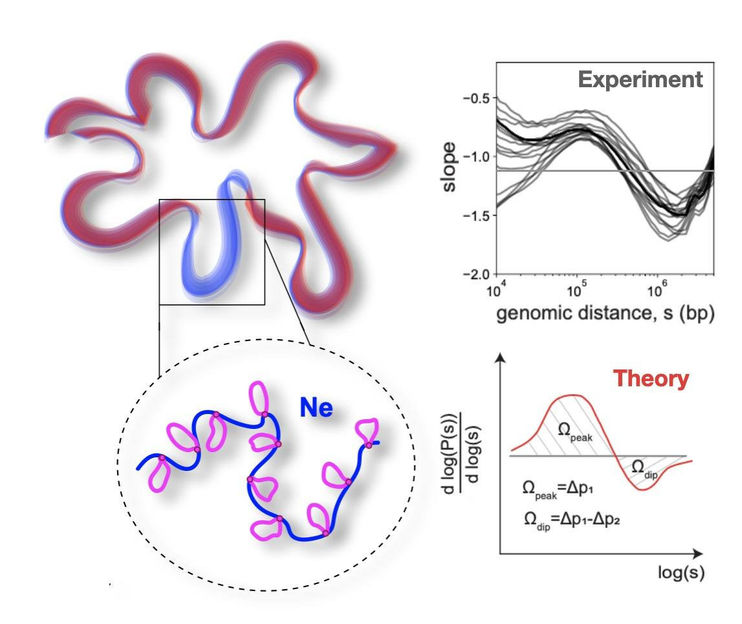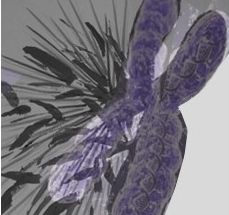Physicists observed random loops in chromosomes and revealed how loops affect spatial organization of genome
Advertisement
Human chromosomes are long polymer chains that store genetic information. The nucleus of each cell contains the entire human genome (DNA) encoded on 46 chromosomes with the total length of about 2 meters. To fit into the microscopic cell nucleus and at the same time provide constant access to genetic information, chromosomes are folded in the nucleus in a special, predetermined way. DNA folding is an urgent task at the intersection of polymer physics and systems biology.

Image 1. Chromosome with loops (on the left) and the peak-dip derivative curve of the contact probability (on the right). On large and small scales, chromosome folding differs significantly due to the “dilution of entanglements” effect created by loops.
Kirill Polovnikov
A few years ago, as one of the mechanisms of chromosome folding, researchers put forward a hypothesis of active extrusion of loops on chromosomes by molecular motors. Although the ability of motors to extrude DNA in vitro has been demonstrated, observing loops in a living cell experimentally is a technically very difficult, almost impossible, task. A team of scientists from Skoltech, MIT, and other leading scientific organizations in Russia and the U.S. presented a physical model of a polymer folded into loops. The analytical solution of this model allowed scientists to reproduce the universal features of chromosome packing based on the experimental data — the image shows the peak-dip derivative curve of the contact probability. The theoretical work will allow researchers to understand how loop extrusion affects the biophysical properties of the chromosome and extract parameters of these loops from the experimental data. The article is published in the Physical Review X journal.
“The extrusion of loops by motors, as is often the case in biology, is random: they constantly form and disappear. This, in particular, explains why their experimental detection in a single living cell is so difficult. We took a different approach: we developed a physical theory that shows how randomly distributed loops on a polymer would affect the spatial organization of the polymer. Next, we analyzed experimental data on the spatial packing of chromosomes obtained on billions of living cells and found the same statistical features there,” says Kirill Polovnikov, the leading author of the study, an assistant professor, and the head of the research group at Skoltech.
The developed theory has allowed determining the typical size of chromosomal loops and their density. In addition, the authors have discovered a new topological effect associated with loops. When the loops are extruded, the backbone of the chain shortens, however, it stretches out in the three-dimensional space due to the so-called “dilution of entanglements” effect in the polymer system. The scientists have developed an analytical model of this effect and also confirmed their results in computer simulations. The theory helps identify and characterize chromosomal loops using experimental data and changes our understanding of the topological organization of chromosomes in a living cell.
“Just as astrophysicists find new exoplanets by the decrease of the luminosity of the parent star during the passage of the planet, our theory offers a tool for detecting the ‘trace’ of loops in the genomic data. Surprisingly, the identified characteristics turn out to be universal not only for humans, but also for the cells of other organisms. Apparently, the folding of chromosomes into loops is one of the most general principles of the spatial organization of DNA,” adds Kirill Polovnikov.























































